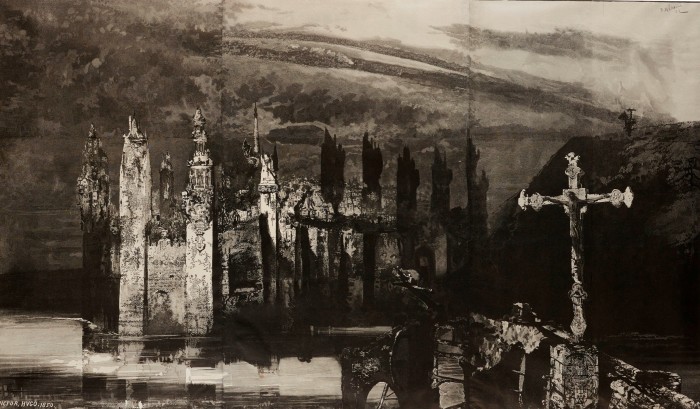Unlock the Editor’s Digest for free
Roula Khalaf, Editor of the FT, selects her favourite stories in this weekly newsletter.
Astonishing Things: The Drawings of Victor Hugo
Royal Academy, to June 29

Seventy superb pieces feature in the Royal Academy’s Astonishing Things. Doubly appealing, the exhibition offers both biographical revelation — the Les Misérables novelist was a draughtsman of real originality and expressive depths — and a scarcely known, very beautiful chapter in 19th-century graphic art. Read the FT’s full review
Noah Davis
Barbican, to May 11

In 2013, the painter Noah Davis was diagnosed with terminal cancer and in 2015 he died, aged 32. A decade later, it is clear that no American figurative painter of his generation matches Davis’s virtuosity, humanity, individual vision, authoritative engagement with art history and sheer haunting loveliness. The show moves to the Hammer Museum Los Angeles, June 8-August 31. Read the FT review
Edvard Munch Portraits
National Portrait Gallery, to June 15

For all the pleasures of passionate eloquence and radiant colour in his portraits, you see why few of his subjects cared for Edvard Munch’s depictions. His essential idea that personality is a battleground, created by conflicting desires and repressions, pours into each painting and makes everyone appear troubled or awkward. That extreme psychological truth was what Munch sought, both by depicting people as individuals and, in his 1890s symbolist pictures “The Scream”, “Vampire” and “Melancholy”, making them icons of intense emotion. Read the FT review
José María Velasco: A View of Mexico
National Gallery, to August 17

The National Gallery’s first ever show devoted to a Latin American artist shines a light on Velasco, the 19th-century painter who helped Mexico to see itself. Treasured at home and rarely loaned, 14 canvases plus a handful of works on paper show the richness of the country’s unique topography, flora and fauna. Travels to the Minneapolis Institute of Art, September 27-January 4 2026. Read the FT review
Grayson Perry: Delusions of Grandeur
Wallace Collection, to October 26

Three years in the making, this is Grayson Perry’s sharp-witted response to the old mansion’s holdings, presenting more than 40 new works by the Turner Prize-winning artist. Read an interview with Grayson Perry
Siena: The Rise of Painting, 1300-1350
National Gallery, to June 22

Uniting works — and altarpieces — unseen together for hundreds of years, and unlikely to be under the same roof again, the exhibition proposes 14th-century Siena as a dawn of the Renaissance: distinctive for the beauty, material splendour and refined delicacy of its paintings, sculptures and decorative objects, significant for its impact. Read the FT review
Goya to Impressionism: Masterpieces from the Oskar Reinhart Collection
Courtauld Gallery, to May 26

Every painting in this gathering of two dozen works visiting from the villa museum Am Römerholz in Winterthur, Switzerland, is not only delicious and memorable; each holds special weight within the artist’s oeuvre, or mattered particularly to another artist. Among them is an exceptional Monet, “La Débâcle”. Read the FT review
Electric Dreams: Art and Technology Before the Internet
Tate Modern, to June 1

A blast for the senses in a show bringing together work from more than 70 artists inspired by and creating art with technology between the end of the second world war and the dawn of the internet as we know it in the early 1990s. Read the FT preview
Brasil! Brasil! The Birth of Modernism
Royal Academy, to April 21

This upbeat tonic of an exhibition presents 10 artists from two generations, born 1880s-1920s. The show, arranged as individual artist displays, introduces some of Latin America’s most exuberant painters, and is lightly curated, refreshingly free of politics and jargon even though it hinges on a postcolonial narrative. Read the FT review
Versailles: Science and Splendour
Science Museum, to April 21

This elegantly eccentric exhibition concentrates on the palace of Versailles’ lost reputation as a centre of scientific excellence. The show is filled with choice pieces, miracles of ingenuity or beauty — often both — that tell a story of wonder and obsessions, of theft, shipwrecks and knuckle-gnawing medicine. Read the FT review
